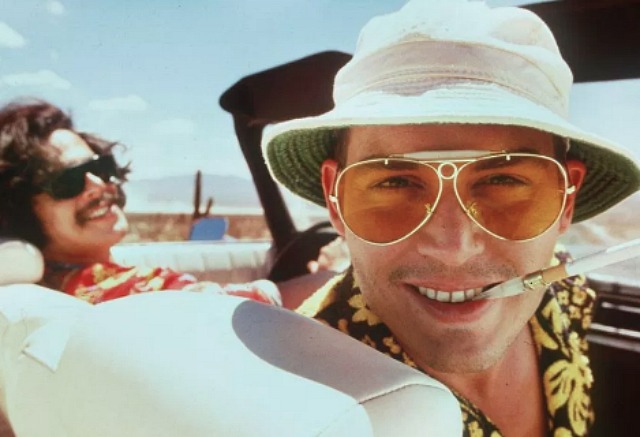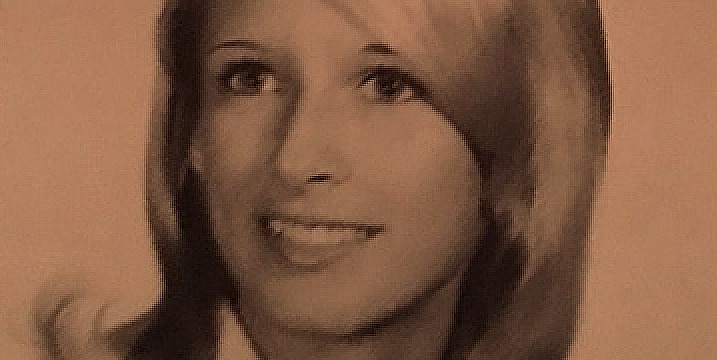One of the best iPhone snaps I’ve ever taken in Italy. The light was perfect and the silhouette effect with the trees was flawless. Just lucky, I guess. Taken near Panzano, looking south, on or about 5.29.17 in the late afternoon.
 Jeffrey Wells
Jeffrey Wells
21st Century Acid Movies
I’m not sure if the following notion is worth exploring, but I’m wondering which noteworthy 21st Century films would be enhanced if you watched them while tripping on LSD. I say this not having come within miles of the stuff since the pre-Watergate Nixon administration, but there used to be this notion that certain films would take on a quality of dimensional extra-ness (more poignant, hilarious, emotional, profound, meaningful) if you watched them after dropping a tab of Orange Wedge or Blue Cheer.
Curious as this might sound, Sydney Pollack‘s Castle Keep, which is kind of a trippy film to begin with, plays really well under this condition. So do Peter Bogdanovich‘s The Last Picture Show and What’s Up, Doc?. But not Targets.
[Click through to full story on HE-plus]
Forget That Award-Season Filter
Dispensing with any notions of awards or nominations, here are HE’s favorite 2018 films (i.e., a combination of the most artful and emotionally satisfying) as we speak, and in this order:
(1) Peter Farrelly‘s Green Book, (2) tie between Alfonso Cuaron‘s Roma and Pawel Pawlikowski‘s Cold War, (3) Paul Schrader‘s First Reformed, (4) Stefano Sollima‘s Sicario — Day of the Soldado, (5) Marielle Heller‘s Can You Ever Forgive Me?, (6) Matt Tyrnauer‘s double-header of Studio 54 and Scotty and the Secret History of Hollywood, (7) Jason Reitman‘s The Front Runner, (8) Chris McQuarrie and Tom Cruise‘s Mission : Impossible — Fallout, (9) Bradley Cooper‘s A Star Is Born, (10) Damien Chazelle‘s First Man.
Followed by (11) Antoine Fuqua‘s The Equalizer 2, (12) Susan Lacy‘s Jane Fonda in Five Acts, (13) Eugene Jarecki‘s The King, (14) Ari Aster‘s Hereditary, (15) Morgan Neville‘s double-header of They’ll Love Me When I’m Dead and Won’t You Be My Neighbor?, (16) Lynne Ramsay‘s You Were Never Really Here, (17) Tony Zierra‘s Filmworker, (18) Bo Burnham‘s Eighth Grade and (19) Bryan Singer‘s Bohemian Rhapsody (for the Live Aid finale). (20) Nadine Labaki’s Capernaum.
Jello in Jail
At one point Seth Meyers‘ jailbird character says to Kenan Thompson‘s “Bill Cosby”, “This is gonna sound mean but have you ever considered just dying?” Cosby is an animal, I know, but that’s not funny.
Suffocation of the Soul
An earlier incarnation of this post appeared on 9.15.14: My childhood was a gulag experience. So were my teens. Things started to get a little better when I began as a film journalist but my life didn’t really pick up until ’80 or thereabouts. And even then it was constant struggle, struggle, toil and trouble. Aleksandr Solzhenitsyn may have lived a tough life but so did I.
I started to feel really badly about life’s possibilities when I seven or eight. The misery seemed to intensify when I turned 11 and 12, but the onset of puberty seemed to make things worse in so many ways. I used to argue with myself about which parent I despised more, as they were awful in their own specific ways. My only encounters with happiness, however brief, came from hanging with certain friends and catching new films at my local theatre (the Westfield Rialto) and on WOR’s Million Dollar Movie or the CBS Late Show when I visited my grandmother, who would always let me stay up as late as I wanted.
My home town of Westfield, New Jersey, was a pleasant enough place, but the social aggression and general bullshit in junior high school meant there was always a taunt and a challenge and some kind of shit going on behind your back. A fairly rancid atmosphere. Everything was awkward or tortured or tedious.
My basic response was to say “fuck this concentration camp and the fucking rules you have to live by or live up to,” and to start living in my own realm, which for me meant the universe of cinema. At age 13 or 14 I got into the habit of taking the bus into Manhattan (a secret mission as my parents wouldn’t let me go alone) and just roaming around Times Square and looking at the various marquees and just soaking it all up. I’d take the bus in the late morning, visit Mecca for three or four hours and get back for dinner by 5 or 6 pm. I paid for these trips with my modest weekly allowance plus a little extra lawn-mowing money.
I used to love the smell of bus exhaust inside those Port Authority parking areas. To me those fumes were the city itself — they smelled like oxygen.
Son of Nobody’s Perfect
James T. Wells, Jr., my witty, well-educated, occasionally surly dad, died a little more than a decade ago. He wasn’t always surly — he could also be snappy and sullen. He also did grumpy. I posted the following on 6.21.08:
My father had 86 years of good living, mostly. He was miserable at the end, lying in a bed and watching TV, reading and sleeping and not much else. I think he wanted to go because his life had been reduced to this. He was a good and decent man with solid values, and he certainly did right by me and my brother and sister as far as providing and protecting us and doing what he could to help us build our own lives.
But he was also, to me, a crab and a gruff, hidden-away soul (his Guam and Iwo Jima traumas as a Marine during World War II mashed him up him pretty badly) and even, it seemed at times, something of a bitter curmudgeon. But not altogether.
I feel very badly for his suffering the indignities of old age and the mostly horrible life he lived over his final year or two. I know that whatever issues I have with my manner, attitude or personality, it is my charge alone to deal with, modify and correct them. But I also know deep down that Jim Wells was the father of it. He lived in a pit so deep and dark you needed a kleig light to see around.
He was a lifelong Democrat who hated John Wayne for his pro-war posturings. He liked Simon and Garfunkle but never got the Beatles, which always flabbergasted me. He actually thought that Michael Herr‘s Dispatches was a waste of time. My brother tried to get him to watch The Limey and he wouldn’t do it. He lived in his own world and could be a real pain to hang with at times. He was foul and nasty and a snappy contrarian about everything during a trip we took to Lake George about 12 years ago. My son Dylan (who was with us) and I did everything we could to escape his company.
I distinctly remember feeling tear-struck in 1986 when I learned of the death of Cary Grant, whom I’d always regarded as a beloved debonair uncle of sorts. I didn’t feel anything close to that when I heard the news about my dad the night before last. The truth is the truth.
Easy Sell
When that “where’s the flag-planting sequence?” complaint about First Man broke at the time of the Telluride Film Festival, my response was that the flag actually appears in the film three or four times, including a shot of the moon flag as well as a brief but unmissable flag-unfurling scene featuring one of Neil Armstrong‘s sons.
Except I was apparently wrong about the count.
According to a 10.12 Huffpost piece by Bill Bradley, the U.S. flag appears no fewer than 18 times in Damian Chazelle‘s film. Presuming this is true, the issue could have been shut down so easily if Universal marketing had simply hired an ad agency to assemble all 18 flag shots and make a patriotic YouTube video out of said footage. Maybe some talking-head quotes about the duty-and-patriotism aspects from Chazelle, Ryan Gosling, Claire Foy, a NASA rep, Buzz Aldrin…would’ve been a snap.
Those Days, That Time…
Now that Matt Tyrnauer‘s Studio 54 is playing on both coasts and some have presumably seen it, what are the reactions? There’s no way I’ve oversold or overpraised it but does anyone think I might have? Is it mostly an older person’s nostalgia trip or is there some interest among 20- and 30somethings? It made around $28K at Manhattan’s IFC Center after a week; the Los Angeles Nuart booking began last night.
Here’s a chat I did with Tyrnauer 10 or 11 days ago.
If Only They’d Consulted Thelma Adams
In the wake of Richard Brody‘s “why is First Man so white?” critique (“Brody Fulfills Prophecy,” posted on 10.11), RealClear’s Thelma Adams is the latest to carry the identity politics torch:
“Fifty years [after NASA’s first manned flight to the moon] America doesn’t do such an out-of-this-world job when it comes to racial inclusivity,” Adams has written. “First Man is a reminder of such inequality.
“The early reception for Damien Chazelle’s space epic since its premiere at the Telluride Film Festival last month has been superlative. Under the National Review headline “First Man is the movie of the Year,” my friend and former New York Post colleague Kyle Smith joined with the majority who found the biopic 82 percent fresh on Rotten Tomatoes. He crowed “First Man is why we go to the movies.”
“To that I ask, ‘What do you mean we, white man?’
“Nothing like the last month in America shows the cracks in the American melting pot, and the impossibility of a cultural ‘we.’ Most semi-woke individuals sometime during the 141-minute movie will notice the absence of people of color in speaking roles. Not there on the mammoth screen. Not there historically. Not in space. And possibly absent from the audience.”
In other words, Adams seems to be saying, First Man would have been more in synch with woke America and might have generated a more bountiful box-office if Chazelle had ignored history and cast an African=American actor in one of the principal roles.
She seems to be suggesting that First Man would have been in better cultural shape if Chazelle had cast, say, Chiwetel Ejiofor as Ed White, one of the Appollo astronauts who tragically died on the Cape Kennedy launch pad in 1967. Or as Roger Chaffee or Virgil “Gus” Grissom.
Why not, right? The only thing that matters these days is inclusion and representation. Hollywood has a duty to push back against racial discrimination in all its forms, and that includes accurate but harmful depictions of U.S. history.
Shut Up, Colonel
While watching Paramount’s 4K-restored, wire-free War of the Worlds, I was again perplexed by that vaguely obnoxious Colonel character (played by the late Vernon Rich) pronouncing “hill three” as “hill thuh-ree“. This always struck me as an excessive application of military-speak. Obviously “thuh-ree” is about verbal clarification over a possibly squawky military radio, but what other other number sounds even a little bit similar? Saying “thuh-ree” for emphasis is like saying “fi-yi five” or “ay-yay-eight” or “ni-yi-nine.” Again, the mp3.

Hypocrisy Was The Topic
Chelsea Handler obviously wasn’t implying there was anything wrong or unfortunate about Sen. Lindsey Graham possibly being closeted, which I know nothing about one way or the other and am not interested in discussing. Handler was alluding to a possible vein of hypocrisy on his part, given HRC’s 2016 statement that Graham “has been a consistent opponent of everything from marriage equality to protecting LGBT workers from employment discrimination.” If, that is, there’s some factual basis to the loose talk.
Girlfriend Chronicles: “I Crave Your Bod”
I’m not saying all high-school girls are fickle and flighty, but a lot of them are. Or were, at least, when I was an awkward, insecure schlemiel.
In my senior year I had it bad for a great Irish blonde named Sally Jo Quinn. Or so she seemed at the time. Short, slender, magnificent blue eyes, straight blonde hair, smallish feet, slender hands with chewed nails. No dad at home; just her single mom who worked as an administrative something-or-other at the high school. I can’t recall if the parents had divorced or if the father had died or what.
All I could do was dream about putting the moves on Sally. She wasn’t entirely averse to my attentions as a couple of hot and heavy episodes did happen. Once in my car (i.e., my father’s train-station car) and once while lying on a bed of brown pine needles in a woodsy area near the town reservoir.
[Click through to full story on HE-plus]




